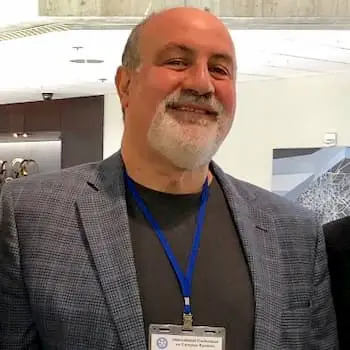Rupert Sheldrake Biography and Wiki
Rupert Sheldrake is an English Ph.D. Holder and a Biologist and Author best known for his hypothesis of morphic resonance. At Cambridge University he worked in developmental biology as a Fellow of Clare College. He was a Principal Plant Physiologist at the International Crops Research Institute for the Semi-Arid Tropics in Hyderabad, India. From 2005 to 2010 he was Director of the Perrott-Warrick project for research on unexplained human and animal abilities, funded by Trinity College, Cambridge.
Rupert Sheldrake Age and Birthday
He is 78 years old as of 2019, he was born on 28 June 1942, Newark-on-Trent, United Kingdom. He celebrates his birthday on 28 June every year and his birth sign is Cancer.
Rupert Sheldrake Nationality
He hold a British citizen.
Rupert Sheldrake Height and Weight
He stands at an average height and has moderate weight. He appears to be quite tall in his photos, relative to his surroundings, are anything to go by. However, details regarding his actual height and other body measurements are currently not publicly available. We are keeping tabs and will update this information once it is out.
Rupert Sheldrake Education
A grammar schoolboy, he went to Cambridge University to study biology. A degree was followed by a Ph.D., and then some post-doctoral work; he was elected a Fellow of Clare College. Had he continued along the standard career path, and engaged in conventional research, he may well have become a quite respected professor.
However, in mid-career, and over a gradual period starting in the late-1970s and finishing in the mid-1980s, he dropped out of eng aging in the scientific process. He has held no academic positions since then. The dropping out process started with a career break travel to India, where he spent some time in a Christian monastery.
Then, instead of returning to his original research program, he wound up doing crop physiology research for an agricultural institute in India — considerably less prestigious than world-renowned Cambridge. He also discovered that instead of doing real science, writing books about New Age woo was much more profitable.
He continues to claim that he is a scientist, but he clearly doesn’t follow the scientific method. He and his supporters like to appeal to authority based on his credentials, often describing him as a “Cambridge University biologist”. To someone without an understanding of how science works (for example those without a background education in science), this may seem impressive.
Rupert Sheldrake Family- Parents and Siblings
He was born in Newark-on-Trent, Nottinghamshire, to Doris and Reginald Alfred Sheldrake (1903–1970) on 28 June 1942. His father graduated from the University of Nottingham with a degree in pharmacy and was also an amateur naturalist and microscopist. It is also not known if he has any siblings. We will update this section once this information is available.
Rupert Sheldrake Wife, Is he married?
Sheldrake is married to a therapist, voice teacher, and author Jill Purce. They have two sons, the biologist Merlin Sheldrake and the musician Cosmo Sheldrake.
Rupert Sheldrake Net worth
Rupert has an estimated net worth of $3 million dollars as of 2020. This includes his assets, money, and income. His primary source of income is his career as an Author. Through his various sources of income, he has been able to accumulate a good fortune but prefers to lead a modest lifestyle.
Rupert Sheldrake Measurements and Facts
Here are some interesting facts and body measurements you should know about Rupert Sheldrake
Rupert Sheldrake Bio and Wiki
- Full Names: Rupert Sheldrake
- Popular As: Rupert Sheldrake
- Gender: Male
- Occupation / Profession: Author
- Nationality: British
- Race / Ethnicity: White
- Religion: Christian
- Sexual Orientation: Straight
Rupert Sheldrake Birthday
- Age / How Old?: 78 years old
- Zodiac Sign: Cancer
- Date of Birth: 28 June 1942
- Place of Birth: Newark-on-Trent, United Kingdom
- Birthday: 28 June
Rupert Sheldrake Body Measurements
- Body Measurements: To be updated soon
- Height / How Tall?: Average
- Weight: Model
- Eye Color: Brown
- Hair Color: Grey
- Shoe Size: To be updated soon
Rupert Sheldrake Family and Relationship
- Father (Dad): Reginald Alfred Sheldrake
- Mother: Doris
- Siblings (Brothers and Sisters): To be updated soon
- Marital Status: Married
- Wife/Spouse: Married to Jill Purce
- Children: Merlin Sheldrake and the musician Cosmo Sheldrake
Rupert Sheldrake Networth and Salary
- Net Worth: $3 million dollars
- Salary: Under Review
- Source of Income: Author
Rupert Sheldrake House and Cars
- Place of living: United States
- Cars: Car brand to be updated soon
Rupert Sheldrake Morphic Resonance
Morphic resonance is a process whereby self-organizing systems inherit a memory from previous similar systems. In its most general formulation, morphic resonance means that the so-called laws of nature are more like habits.
The hypothesis of morphic resonance also leads to a radically new interpretation of memory storage in the brain and of biological inheritance. Memory need not be stored in material traces inside brains, which are more like TV receivers than video recorders, tuning into influences from the past. And biological inheritance need not all be coded in the genes, or in epigenetic modifications of the genes; much of it depends on morphic resonance from previous members of the species.
Thus each individual inherits a collective memory from past members of the species, and also contributes to the collective memory, affecting other members of the species in the future.
This hypothesis was first put forward in my book A New Science of Life in 1981, and discussed in greater detail in my main theoretical work, The Presence of the Past, published in 1988. See Morphic Fields for a general introduction to the theory.
A new fully updated edition of A New Science of Life was published in the UK in 2009 (Icon Books, London) and in the US under the title Morphic Resonance (Inner Traditions International, Rochester, VT). In this new edition, Appendix A PDF describes the results of experimental tests since the first edition of the book was published in 1981 and discusses ten new tests. In Appendix B PDF there is a dialogue about morphic fields and quantum physics with the physicist David Bohm.
Rupert Sheldrake Books
Reviews of Sheldrake’s books have at times been extremely negative over their scientific content, but some have been positive. In 2009, Adam Rutherford, geneticist and deputy editor of Nature, criticized Sheldrake’s books for containing research that was not subjected to the peer-review process expected for science, and suggested that his books were best “ignored.”
A New Science of Life (1981)
Sheldrake’s A New Science of Life: The Hypothesis of Morphic Resonance (1981) proposed that through morphic resonance, various perceived phenomena, particularly biological ones, become more probable the more often they occur and that biological growth and behavior thus become guided into patterns laid down by previous similar events. As a result, he suggested, newly-acquired behaviors can be passed down to future generations − a biological proposition akin to the Lamarckian inheritance theory. He generalized this approach to asserting that it explains many aspects of science, from evolution to the laws of nature which, in Sheldrake’s formulation, are merely mutable habits that have been evolving and changing since the Big Bang.
The Presence of the Past (1988)
In The Presence of the Past: Morphic Resonance and the Habits of Nature (1988), Sheldrake expanded on his morphic resonance hypothesis and marshaled experimental evidence which he said supported the hypothesis. The book was reviewed favorably in New Scientist by historian Theodore Roszak, who called it “engaging, provocative” and “a tour de force.” When the book was re-issued in 2011 with those quotes on the front cover, New Scientist remarked, “Back then, Roszak gave Sheldrake the benefit of the doubt. Today, attitudes have hardened and Sheldrake is seen as standing firmly on the wilder shores of science,” adding that if New Scientist were to review the re-issue, the book’s publisher “wouldn’t be mining it for promotional purposes.
The Rebirth of Nature (1991)
Published in 1991, Sheldrake’s The Rebirth of Nature: The Greening of Science and God addressed the subject of New Age consciousness and related topics. A column in The Guardian said that the book “seeks to restore the pre-Enlightenment notion that nature is ‘alive’,” quoting Sheldrake as saying that “indeterminism, spontaneity, and creativity have re-emerged throughout the natural world” and that “mystic, animistic and religious ways of thinking can no longer be kept at bay.”The book was reviewed by James Lovelock in Nature, who argued that “the theory of formative causation makes testable predictions,” noting that “nothing has yet been reported which would divert the mainstream of science. … Even if it is nonsense … recognizing the need for fruitful errors, I do not regard the book as dangerous.”
Seven Experiments That Could Change the World (1994)
In 1994, Sheldrake proposed a list of Seven Experiments That Could Change the World, subtitled “A do-it-yourself guide to revolutionary science.” He encouraged lay people to conduct research and argued that experiments similar to his own could be conducted with limited expense.
The music critic of The Sunday Times Mark Edwards reviewed the book positively, arguing that Sheldrake “challenges the complacent certainty of scientists,” and that his ideas “sounded ridiculous … as long as your thinking is constrained by the current scientific orthodoxy.”
David Sharp, writing in The Lancet, said that the experiments testing paranormal phenomena carried the “risk of positive publication bias,” and that the scientific community “would have to think again if some of these suggestions were convincingly confirmed.” Sharp encouraged readers (medical professionals) to “at least read Sheldrake, even try one of his experiments – but pay very close attention to your methods section.” Sharp doubted whether “a bunch of enthusiastic amateurs [was] going to persuade skeptics,” and noted that “orthodox science will need a lot of convincing.”
Dogs That Know When Their Owners are Coming Home (1999)
Dogs That Know When Their Owners Are Coming Home, published in 1999, covered his research into proposed telepathy between humans and animals, particularly dogs. Sheldrake suggests that such interspecies telepathy is a real phenomenon and that morphic fields are responsible for it.
The book is in three sections, on telepathy, on a sense of direction, including animal migration and the homing of pigeons, and on animal precognition, including premonitions of earthquakes and tsunamis. Sheldrake examined more than 1,000 case histories of dogs and cats that seemed to anticipate their owners’ return by waiting at a door or window, sometimes for half an hour or more ahead of their return. He did a long series of experiments with a dog called Jaytee, in which the dog was filmed continuously during its owner’s absence.
In 100 filmed tests, on average the dog spent far more time at the window when its owner was on her way home than when she was not. During the main period of her absence, before she started her return journey, the dog was at the window for an average of 24 seconds per 10-minute period (4% of the time), whereas when she was on her way home, during the first ten minutes of her homeward journey, from more than five miles away, the dog was at the window for an average of five minutes 30 seconds (55% of the time). Sheldrake interpreted the result as highly significant statistically.
Sheldrake performed 12 further tests, in which the dog’s owner traveled home in a taxi or other unfamiliar vehicle at randomly selected times communicated to her by telephone, to rule out the possibility that the dog was reacting to familiar car sounds or routines. Sheldrake also carried out similar experiments with another dog, Kane, describing the results as similarly positive and significant.
The Sense of Being Stared At (2003)
Sheldrake’s The Sense of Being Stared At explores telepathy, precognition, and the “psychic staring effect.” It reported on an experiment Sheldrake conducted where blindfolded subjects guessed whether persons were staring at them or at another target. Sheldrake reported subjects exhibiting a weak sense of being stared at, but no sense of not being stared at, and attributed the results to morphic resonance. Sheldrake reported a hit rate of 53.1%, describing two subjects as “nearly always right, scoring way above chance levels.”
The Science Delusion (Science Set Free) (2012)
The Science Delusion, published in the US as Science Set Free: 10 Paths to New Discovery, summarises much of Sheldrake’s previous work and encapsulates it into a broader critique of philosophical materialism, with the title apparently mimicking that of The God Delusion by one of his critics, Richard Dawkins.
In the book, Sheldrake proposes a number of questions as the theme of each chapter which seeks to elaborate on his central premise that science is predicated on the belief that the nature of reality is fully understood, with only minor details needing to be filled in. This “delusion” is what Sheldrake argues has turned science into a series of dogmas grounded in philosophical materialism rather than an open-minded approach to investigating phenomena. He argues that there are many powerful taboos that circumscribe what scientists can legitimately direct their attention towards.:6–12The the mainstream view of modern science is that it proceeds by methodological naturalism and does not require philosophical materialism.
Rupert Sheldrake Ted Blog
At TEDxWhitechapel on January 13, 2013, Rupert Sheldrake gave a provocative talk in which he suggests that modern science is based on ten dogmas, and makes the case that none of them hold up to scrutiny. According to him, these dogmas including, for example, that nature is mechanical and purposeless, that the laws and constants of nature are fixed, and that psychic phenomena like telepathy are impossible — have held back the pursuit of knowledge.
TED’s scientific advisers have questioned whether his list is a fair description of scientific assumptions indeed, several of the dogmas are actually active areas of scientific inquiry (including whether physical ‘constants’ are really unchanging) and believe there is little evidence for some of Sheldrake’s more radical claims, such as his theory of morphic resonance, and claim that the speed of light has been changing. They recommended that the talk is should not be distributed without being framed with caution. Accordingly, we have reposted his talk here, with the above cautionary introduction. We invite scientists, skeptics, knowledge-seekers, and supporters and Sheldrake himself if he’s willing to view and discuss the talk.
At TEDxWhitechapel on January 13, 2013, Rupert Sheldrake gave a provocative talk in which he suggests that modern science is based on ten dogmas, and makes the case that none of them hold up to scrutiny. According to him, these dogmas including, for example, that nature is mechanical and purposeless, that the laws and constants of nature are.
Rupert Sheldrake Morphic Fields
Sheldrake probably provokes such strong reactions in part because he is a product of the scientific establishment—more specifically, of Cambridge University. He earned his doctorate in biochemistry there in 1967 and became a fellow and director of studies in biochemistry and cell biology. He gradually became dissatisfied with current theories of biology. He presented an alternative framework involving his theory of morphic resonance (explained below) in his 1981 book A New Science of Life, which Maddox, in a now-famous Nature editorial, called “the best candidate for burning there has been for many years.
Rupert Sheldrake Quotes
- What you do, what you say, and what you think can influence other people by morphic resonance. There is no immoral filter in morphic resonance, which means that we have to be more careful about what we are thinking if we are concerned about the effect we have on others.
- Bad religion is arrogant, self-righteous, dogmatic, and intolerant. And so is bad science. But unlike religious fundamentalists, scientific fundamentalists do not realize that their opinions are based on faith. They think they know the truth
- The universe is not in a steady-state; there’s an ongoing creative principle in nature, which is driving things onwards.
- The science delusion is the belief that science already understands the nature of reality in principle, leaving only the details to be filled in.
- Creativity gives new forms, new patterns, new ideas, new art forms. And we don’t know where creativity comes from. Is it inspired from above? Welling up from below? Picked up from the air? What? Creativity is a mystery wherever you encounter it.
- The idea is that there is a kind of memory in nature. Each kind of thing has a collective memory. So, take a squirrel living in New York now. That squirrel is being influenced by all past squirrels.
- In practice, the goal of skepticism is not the discovery of truth, but the exposure of other people’s errors. It plays a useful role in science, religion, scholarship, and common sense. But we need to remember that it is a weapon serving belief or self-interest; we need to be skeptical of skeptics. The more militant the skeptic, the stronger the belief.
- Basically, morphic fields are fields of habit, and they’ve been set up through habits of thought, habits of activity, and habits of speech. Most of our culture is habitual.
Rupert Sheldrake Birds
He has worn that mantle, pretty cheerfully, for 30 years now. Sitting in his book-lined study, overlooking Hampstead Heath, he appears a highly unlikely candidate for apostasy; he seems more like the Cambridge biochemistry don he once was, one of the brightest Darwinians of his generation, winner of the university botany prize, a researcher at the Royal Society, Harvard scholar and a fellow of Clare College.
All that, though, was before he was cast out into the wilderness. Sheldrake’s untouchable status was conferred one morning in 1981 when, a couple of months after the publication of his first book, A New Science of Life, he woke up to read an editorial in the journal Nature, which announced to all right-thinking men and women that he was a “book for burning” and that Sheldrake was to be “condemned in exactly the language that the pope used to condemn Galileo, and for the same reason. It is heresy”.
Rupert Sheldrake Books Pdf
This is the third in his series of essays by Rupert Sheldrake on the implications of his hypothesis of Formative Causation for the psychology of C. G. Jung. The intense controversy this hypothesis generated with the publication of his first book, A New Science of Life (1981), has stimulated a number of international competitions for evaluating his ideas via experimental investigations.
Rupert Sheldrake Panpsychism
There seems to be a growing number of materialist scientists for whom the electrical ball of meat theory is also beginning to show weakness. To take a small step away from that theory, some are now using the term ‘Panpsychism’ to describe how they are viewing consciousness.
Panpsychism is in philosophy, panpsychism is the view that consciousness, mind, or soul (psyche) is a universal and primordial feature of all things. Panpsychists see themselves as minds in a world of the mind.
It’s not a new idea. In fact, it’s a very ancient one that was popular for a long time, until the rise of ‘logical positivism’. The recognition of the very hard problem of defining consciousness has brought it right back. It’s a good place to start the discussion again.
So according to Panpsychism, consciousness is within everything. From the whale all the way to the electron. The human mind, being one of the greatest concentrations of electrons on the planet, makes us aware of our own consciousness. At least by our own definition of what makes consciousness. This struck me as very Animistic. That everything has consciousness – from the pebble to the mountain, from the raindrop to the ocean. Replace consciousness with the word Spirit and it’s getting very close to the way I know many Pagans view things.
Rupert Sheldrake Determinism
He has established himself as the world’s central figure in the evolutionary theory of existence. Heir to the lineage of Darwin, Peirce, Bergson, Elsasser, and Bohm, Sheldrake bears on his shoulders the weight of their worldview. Attacks on his work amount to an offensive against any alternative to a universe under the control of eternal immutable laws.
In 1980 Bohm proposed that material events are abstracted into an “implicate” order that influences subsequent events in the day “explicate” realm. The following year, Sheldrake proposed that current organic events are influenced by a composite of previous, similar events.
Are these different theories or just the same theory arrived at by different means? When the scientists got together to discuss their work, they weren’t sure. Yet their books received radically different receptions. Bohm’s Wholeness and the Implicate Order was treated with the respect owing to any scientific work, while Sheldrake’s A New Science of Life evoked not just hostility but hysteria and out-of-thin-air accusations of pseudoscience.
Rupert Sheldrake Conference
His first book was published in 1981. Sir John Maddox reviewed it for Nature, writing. His book is a splendid illustration of the widespread public misconception of what science is about. In reality, Sheldrake’s argument is in no sense a scientific argument but an exercise in pseudo-science.
He was a frequent contributor to The Guardian during the 1980s, especially to its “body and soul” column, seemingly as a result of Guardian editor Brian Inglis being somewhat of a fan.
He has devoted much thought and speculation towards trying to find causes for some of life’s more peculiar and spooky occurrences: such as how dogs seem to know their owners are coming home, how separated siblings sometimes seem to experience symptoms of the other’s illness despite living in a different continent, and how it takes bloody ages to try and get a protein to crystallize, but once one lab manages it, lots of others seem to be able to with ease.
Science generally has no explanation for observations of such happenings, and indeed scientific wisdom would suggest there can be no causal reason for them and they are simply flukes and/or people seeing patterns that are not there. He, however, has developed the concept of the “morphic field” in an attempt to explain them.
According to his 1981 book A New Science of Life, such a field would make it so that once a species has evolved, the next species to evolve would look something like it, apparently due to the Universe having a memory since it is alive.
In 1960, Ninian Marshall published a paper titled ESP and Memory. A Physical Theory. In the paper, he proposed a hypothesis of “resonance”, which basically said there is some kind of mysterious energy in nature that can explain biological mysteries and telepathic experiences. It’s clear that his “morphic resonance” was influenced by this paper. In his book, he mentions the Marshall paper only in a footnote but admits that his own idea is similar to it in “several important” ways.
In January 2013, He and the pseudohistorian Graham Hancock gave lectures at the TEDxWhitechapel in East London. In his lecture, he criticized modern science, listing what he called “ten dogmas of modern materialist science” that he feels are assumptions without evidence.
He is the owner of the anti-skeptic site “Skeptical Investigations” which claims to debunk skeptics. It is actually a woo haven for all kinds of crank ideas and pseudoscience.
Rupert Sheldrake Public reception
Sheldrake’s ideas have been discussed in academic journals and books. His work has also received popular coverage through newspapers, radio, television and speaking engagements. The attention he receives has raised concerns that it adversely affects the public understanding of science.
Some have accused Sheldrake of self-promotion, with Steven Rose commenting, “for the inventors of such hypotheses the rewards include a degree of instant fame which is harder to achieve by the humdrum pursuit of more conventional science.”
Frequently Asked Questions About Rupert Sheldrake
Who is Rupert Sheldrake?
He is an English Ph.D. Holder and a Biologist and Author best known for his hypothesis of morphic resonance. At Cambridge University he worked in developmental biology as a Fellow of Clare College. He was a Principal Plant Physiologist at the International Crops Research Institute for the Semi-Arid Tropics in Hyderabad, India.
How old is Rupert Sheldrake?
He is an English Citizen born 28 June 1942, Newark-on-Trent, Nottinghamshire, England.
How tall is Rupert Sheldrake?
He stands at an average height and weight, he appears to be quite tall in his photos, relative to his surroundings, are anything to go by. However, details regarding his actual height and other body measurements are currently not publicly available. We are keeping tabs and will update this information once it is out.
Is Rupert Sheldrake married?
Sheldrake is married to a therapist, voice teacher, and author Jill Purce. They have two sons, the biologist Merlin Sheldrake and the musician Cosmo Sheldrake.
How much is Rupert Sheldrake worth?
His net worth is estimated to be $3 million and $5 million dollars, he has been in the writing industry for quite some time. He has no doubt amassed a huge fortune with the bulk of his wealth comes from his professional author career. Despite his obvious riches, he prefers to lead a modest lifestyle.
Is Rupert Sheldrake dead or alive?
He is alive and in good health. There have been no reports of him being sick or having any health-related issues.
Where is Rupert Sheldrake Now?
He is pursuing his career in the writing industry. He is working on his new books.
Social Media Contacts
Related Biographies.
You may also like to read the Bio, Career, Family, Relationship, Body measurements, Net worth, Achievements, and more about:
Reference:
We acknowledge the following websites that we have referenced as we were writing this article.:
- Wikipedia
- IMDB
- Instagram and
- Youtube
About InformationCradle Editorial Staff
This Article is produced by InformationCradle Editorial Staff which is a team of expert writers and editors led by Josphat Gachie and trusted by millions of readers worldwide.
We endeavor to keep our content True, Accurate, Correct, Original and Up to Date. For complain, correction or an update, please send us an email to informationcradle@gmail.com. We promise to take corrective measures to the best of our abilities.






